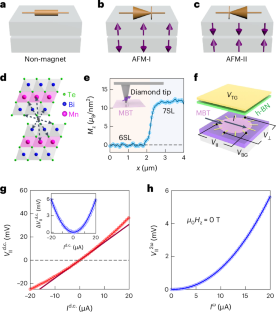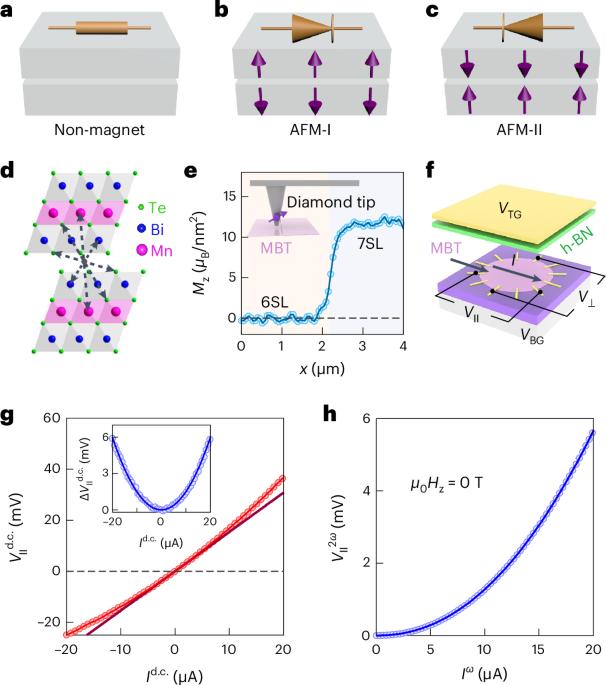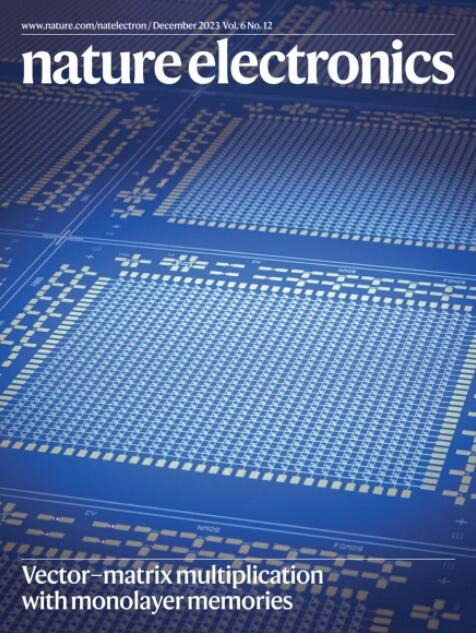An antiferromagnetic diode effect in even-layered MnBi2Te4
IF 33.7
1区 工程技术
Q1 ENGINEERING, ELECTRICAL & ELECTRONIC
引用次数: 0
Abstract
In a p–n junction, the separation of positive and negative charges leads to diode transport, in which charge flows in only one direction. Non-centrosymmetric polar conductors are intrinsic diodes that could be of use in the development of nonlinear applications. Such systems have recently been extended to non-centrosymmetric superconductors, and the superconducting diode effect has been observed. Here, we report an antiferromagnetic diode effect in a centrosymmetric crystal without directional charge separation. We observed large second-harmonic transport in a nonlinear electronic device enabled by the compensated antiferromagnetic state of even-layered MnBi2Te4. We show that this antiferromagnetic diode effect can be used to create in-plane field-effect transistors and microwave-energy-harvesting devices. We also show that electrical sum-frequency generation can be used as a tool to detect nonlinear responses in quantum materials. An antiferromagnetic diode effect was observed in a centrosymmetric crystal without directional charge separation. This effect could be used to create in-plane field-effect transistors and microwave-energy-harvesting devices.


偶数层 MnBi2Te4 中的反铁磁二极管效应
在 p-n 结中,正负电荷的分离会导致二极管传输,其中电荷只朝一个方向流动。非中心对称极性导体是一种本征二极管,可用于开发非线性应用。最近,这种系统已扩展到非中心对称超导体,并观察到了超导二极管效应。在这里,我们报告了在没有定向电荷分离的中心对称晶体中的反铁磁二极管效应。我们在偶数层 MnBi2Te4 的补偿反铁磁态的非线性电子器件中观察到了大量的二次谐波传输。我们表明,这种反铁磁二极管效应可用于制造面内场效应晶体管和微波能量收集器件。我们还展示了电总频生成可用作检测量子材料中非线性响应的工具。
本文章由计算机程序翻译,如有差异,请以英文原文为准。
求助全文
约1分钟内获得全文
求助全文
来源期刊

Nature Electronics
Engineering-Electrical and Electronic Engineering
CiteScore
47.50
自引率
2.30%
发文量
159
期刊介绍:
Nature Electronics is a comprehensive journal that publishes both fundamental and applied research in the field of electronics. It encompasses a wide range of topics, including the study of new phenomena and devices, the design and construction of electronic circuits, and the practical applications of electronics. In addition, the journal explores the commercial and industrial aspects of electronics research.
The primary focus of Nature Electronics is on the development of technology and its potential impact on society. The journal incorporates the contributions of scientists, engineers, and industry professionals, offering a platform for their research findings. Moreover, Nature Electronics provides insightful commentary, thorough reviews, and analysis of the key issues that shape the field, as well as the technologies that are reshaping society.
Like all journals within the prestigious Nature brand, Nature Electronics upholds the highest standards of quality. It maintains a dedicated team of professional editors and follows a fair and rigorous peer-review process. The journal also ensures impeccable copy-editing and production, enabling swift publication. Additionally, Nature Electronics prides itself on its editorial independence, ensuring unbiased and impartial reporting.
In summary, Nature Electronics is a leading journal that publishes cutting-edge research in electronics. With its multidisciplinary approach and commitment to excellence, the journal serves as a valuable resource for scientists, engineers, and industry professionals seeking to stay at the forefront of advancements in the field.
 求助内容:
求助内容: 应助结果提醒方式:
应助结果提醒方式:


